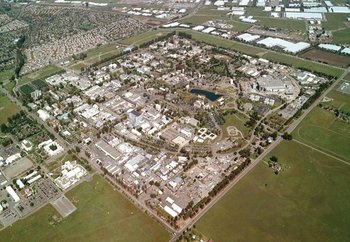Lawrence Livermore National Laboratory
|
|
The Lawrence Livermore National Laboratory (LLNL) is a United States Department of Energy national laboratory, managed by the University of California, in Livermore, California. Along with Los Alamos National Laboratory, it is one of the USA's two laboratories whose mission has included the design of nuclear weapons. The laboratory's self-described purpose currently is "to promote innovation in the design of our nation's nuclear stockpile through creative science and engineering." The laboratory's field of research has expanded to include general energy issues, as well as biomedicine and environmental science.
The site, at the location of a former World War II Naval Training Station, was originally used to house projects of the University of California Radiation Laboratory which were too large for its location on the hills of Berkeley, California. In 1949, Edward Teller suggested to Ernest Lawrence, head of the Berkeley lab, that a second weapons lab be created as "competition" with the lab which sprung up to create the first atomic bomb, Los Alamos. Teller's advocacy for the lab was also in response to his frustrations with the low-priority he felt his idea of a hydrogen bomb was getting at Los Alamos. In 1951, Teller formally appealed to the Atomic Energy Commission for the creation of the laboratory, and in September 1952 the lab was formally founded. Despite Teller's original motivation, however, the hydrogen bomb was primarily designed at Los Alamos.
32-year old Herbert York was appointed the first director of the lab. York set out to develop the Lab's program and created four main elements: Project Sherwood (the Magnetic Fusion Program), diagnostic weapon experiments (both for Los Alamos and Livermore), the design of thermonuclear weapons, and a basic physics program. The first two facilities were a building to house the latest electronic computer, a UNIVAC I, and a technology building with a large central bay for lifting heavy equipment.
Throughout the Cold War, Lawrence Livermore competed with Los Alamos to design the nation's nuclear arsenal, as well as perform other science and technology related tasks (some classified, some not). In the early 1990s their weapons work shifted into stockpile stewardship.
Computers at the lab
The first computer the laboratory possessed was a UNIVAC I, ordered in July through September 1952 and delivered in April 1953.
Over the years other computers were installed, including:
- 2 IBM 701s
- 4 IBM 704s
- 4 IBM 709s
- 4 IBM 7090s
- 1 UNIVAC LARC
- 5 IBM 7094s
- 1 IBM 7030 (Stretch)
- 1 CDC 1604
- 2 CDC 3600s
- 4 CDC 6600s
- 5 CDC 7600s
- 2 CDC STAR 100s
- 4 Cray-1s
- 5 Cray X-MPs
- 3 Cray-2s
- 2 Cray Y-MP8s
- 1 BBN Butterfly
- 1 Cray C90
- 1 Meiko
- 1 Cray T3D
- IBM ASCI Blue Pacific
- IBM ASCI White
- ASCI Purple
- IBM Blue Gene/L.
References
- Nuclear Rites: A Weapons Laboratory at the End of the Cold War by Hugh Gusterson (ISBN 0520213734)
External links
- LLNL.gov (http://www.llnl.gov) (official)
- Laboratory History (http://www.llnl.gov/50th_anniv/history.htm) (official)
Template:Geolinks-US-streetscalede:Lawrence Livermore National Laboratory fr:Lawrence Livermore National Laboratory id:Lawrence Livermore National Laboratory ja:ローレンスリバモア国立研究所

